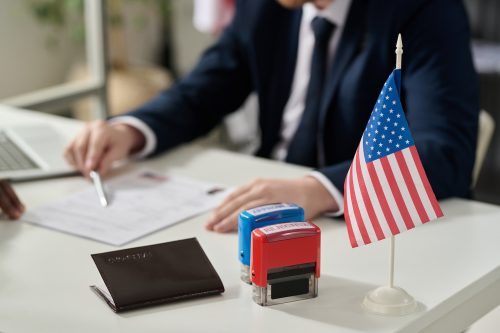The Systematic Alien Verification for Entitlements (SAVE) program is an online electronic system operated by U.S. Citizenship and Immigration Services (USCIS) which provides immigration status information to federal, state, and local government agencies seeking to determine an individual’s eligibility for public benefits. SAVE is different from the E-Verify system, which can only be used by employers to verify an individual’s authorization to work in the United States. This fact sheet explains the SAVE program, the process through which it verifies an individual’s immigration status, and some of the concerns associated with its operation.
When was the SAVE program created?
In 1986, Congress passed the Immigration Reform and Control Act (IRCA), which prohibited the granting of specified federal public benefits to certain non-citizens. IRCA required non-citizen benefit applicants to show proof of lawful immigration status at the time of application and directed what was then known as the Immigration and Naturalization Service (now USCIS) to establish an automated system for verifying the applicant’s immigration status.The SAVE program was established in 1987 to meet IRCA requirements. Over the years, subsequent legislation has modified and expanded the role of SAVE in the immigration status verification process.
Who can use SAVE?
SAVE provides immigration status verification services to over 1,100 agencies. A government agency is only eligible to use SAVE if it is a federal, state, or local benefit-granting agency that is authorized by law to engage in an activity or provide a benefit for which immigration status verification is required. Except for private airport operators authorized under the Federal Aviation Act, a private company or individual cannot verify immigration status through SAVE.
Before an agency can use SAVE, it must first register with USCIS. If the agency meets the eligibility criteria to participate in SAVE, the agency is required to execute a Memorandum of Agreement (MOA) with USCIS that outlines the purpose of and responsibilities for participation in the program.
How does the SAVE verification process work?
The agency submits an electronic verification request to USCIS using immigration documents provided by the individual, such as a lawful permanent resident card or an employment authorization document. SAVE then compares the information provided with federal government records and either confirms the individual’s immigration status (in which case the process is complete) or asks the agency to send additional information. The majority of SAVE requests are completed without additional verification.
If SAVE cannot immediately confirm an individual’s immigration status, it does not necessarily indicate that the individual is not authorized to be in the United States or is ineligible for the benefit sought. Immigration records may contain errors or incomplete information that would require additional verification of an individual’s status. During the additional verification process, the agency is asked to provide more information about the individual and/or copies of the individual’s immigration documents. A “status verifier” at USCIS reviews the additional information and conducts independent research using available government records to verify whether or not the original response was accurate.
Is SAVE monitored to ensure that it contains accurate information?
USCIS claims to conduct monthly checks to help ensure that SAVE is accurately reporting information contained in its source systems. USCIS also claims that SAVE status verifiers who conducted research during the additional verification process accurately reported the individual’s status 99% of the time.
Individuals themselves may also request additional verification if they disagree with the initial SAVE response. After additional verification, if individuals believe the information provided by SAVE is still inaccurate, USCIS suggests that they make an appointment with the local USCIS office, call the National Customer Service Center, or submit a corrections request to the Freedom of Information Act/Privacy Act (FOIA/PA) Office. However, as described below, concerns remain about whether these options provide adequate recourse to individuals who are incorrectly denied benefits.
How are agencies monitored to ensure they are using SAVE appropriately?
Under the MOA that user agencies sign with USCIS, SAVE’s Monitoring & Compliance (M&C) Branch is authorized to:
- monitor and review all SAVE system usage patterns, training records, user access, and other relevant data;
- conduct site visits and desk audits to review compliance; and
- take corrective measures in a timely manner to address all lawful requirements.
Despite the existence of the M&C Branch, many state and local agencies do not complete the required additional verification steps, as described below.
Are there any concerns regarding the SAVE program?
Despite USCIS’s claim of 99% accuracy upon manual review, SAVE may still provide inaccurate information and, as a result, an eligible individual’s benefits may be incorrectly denied. In the past, some states used SAVE to verify the immigration status of individuals registering to vote in U.S. elections, but discontinued the effort after eligible voters were incorrectly flagged as ineligible.
A U.S. Government Accountability Office (GAO) report in March 2017 stated that the recourse mechanisms implemented by USCIS to correct inaccurate information in SAVE were ineffective and unlikely to enable individuals to make timely record corrections. The guidance provided to individuals for correcting their immigration records was not found to be clear or specific.
The GAO report also found that USCIS did not have sufficient controls to ensure that agencies were correctly following the SAVE verification process or completing the required training that explains the procedure. According to the report, from 2012 to 2016, the majority of participating agencies did not complete the additional steps to verify an individual’s immigration status when prompted by SAVE. Further, the M&C Branch failed to improve agency compliance rates for instituting additional verification when prompted.
In a June 2020 Privacy Impact Assessment, USCIS announced the development of a Person Centric Entity Resolution microservice to improve SAVE’s accuracy by more easily comparing immigration data supplied by the user agency with internal and external systems. The assessment also stated that SAVE will provide further access to relevant reports to support the agency’s monitoring and compliance activities.
What privacy protections exist under SAVE regarding use and disclosure of data?
Agencies using SAVE are responsible for ensuring that the individual’s personal information is used in a non-discriminatory way and only for the purposes outlined in the MOA. All users are required to comply with the Privacy Act and must implement the following safeguards:
- allow only authorized users to access SAVE;
- secure access to SAVE by protecting passwords;
- use and distribute personal information only for official purposes on a need-to-know basis;
- copy or print personal information only when necessary and mark all documents with “For Official Use Only”;
- use a cover sheet when faxing personal information and notify the recipient before transmitting; and
- report suspicious or inappropriate requests for personal information by calling Customer Support.
Agencies also are required to notify individuals that providing personal information is voluntary and that the information will be verified using the SAVE system, as well as inform them of the consequences of not providing the information.


